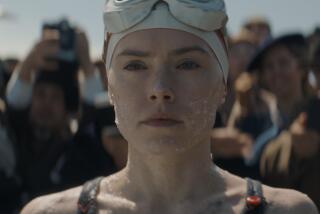Swimming to Siberia : American Lynne Cox Realized an 11-Year-Old Dream When She Splashed Ashore for Tea With the Russians
- Share via
On Friday, Aug. 7, 30-year-old Lynne Cox made medical, political and athletic history by swimming the cold, 2.7-mile channel between America’s Little Diomede Island and the Soviet Union’s Big Diomede Island in the middle of the Bering Strait. Her time was 2 hours, 5 minutes. She was escorted by two walrus-skin umiaks bearing Eskimo guides, a medical support team and a small media contingent, including Rich Roberts , Los Angeles Times staff writer. A similar complement of Soviet personnel met her on the other side. A week later, in the comfort of her home in Los Alamitos where she lives with her parents, she reflected with Roberts on her achievement.
THE 2.7 MILES OF water that separate Alaska and Siberia will soon freeze over, but every time Lynne Cox thinks about what she did there she gets warm all over.
“We were the first Americans to be invited over there since 1948,” she said, “and the Soviets met us at the border and had a tea party for us. That was pretty amazing.”
So was her feat in swimming the frigid, foggy gap between the United States and the Soviet Union. The border is the International Date Line that bisects the Bering Strait. The bizarre tea party was set on a steep, rocky Siberian shore where no civilians of either nation had been permitted to set foot in nearly 40 years.
For 11 years Cox had dreamed of doing what nobody had even attempted. For 2 hours and 5 minutes, she swam in water measured variously at 43 or 44 degrees until, finally, she reached the other side. There she was helped ashore by a Russian hand, treated by a Russian doctor and toasted with Russian tea.
Then, recuperating in a Russian tent, she shivered and listened to Eskimo folk songs sung by American and Siberian Eskimos that the Soviets had reunited as a surprise.
For 16 years Cox had been swimming channels all over the world, but, clearly, this one was different.
“I was more uptight on this swim than anything I’d ever done,” she said. “It was more important to me than anything I’d ever done. Everything was critical.”
It had taken more than two years to arrange the swim, and the Soviets didn’t grant permission or confirm their assistance until the day before Cox swam. She had been told that it might work out that way.
That morning, with the task directly before her, she felt committed and anxious.
Standing before Joe Coplan, the project director, at 8:10 a.m., she said, “I want to go now. It looks good.”
“Ten o’clock,” Coplan told her.
“Nine-thirty,” Cox said.
For her protection Cox was accompanied by Dr. William Keatinge, a specialist in cold-water survival from the London Hospital Medical College, and Drs. Jan Nyboer Sr. and Jr. of Anchorage. But once in the water, her anxiety increased. The water was calm but fog limited visibility to 100 yards.
“It was cold ,” she said. “The first 45 minutes were OK, but when we started getting to the hour mark I could feel the cold increasing, like a constant toothache.”
The people in the boats and Cox played games with each other.
“There were comments afterward that, ‘Gee, you made it look so easy,’ ” Cox said. “But I knew that if I looked like ‘this is cold and this hurts,’ wondering about making it, that would have upset the Nyboers and Keatinge and they would have been ready to pull me out on a moment’s notice.”
Coplan, wearing a wet suit in case Cox needed quick assistance in the water, worked at looking relaxed, for Cox’s sake.
“If you show any anxiety, that’s transmitted to the person in the water,” he said.
Because of the fog and current, Cox missed the beach where the Soviets were waiting by half a mile.
Her escorts told her it would be OK to finish now and see the Soviets later.
“But everyone is looking at the people (waiting) in the snow down there, and I’m thinking, ‘I can’t (stop here), I can’t,’ ” she said. “The point of it was to meet the Soviets, and to land short of that would be to land short of the goal.”
So she swam on, at some risk of life: Once ashore, her body temperature dropped as low as 94 degrees before returning to normal in the warming tent.
What now?
“I’d like to see some of that data applied to people that can use this information to benefit others. I’d like to see us do something with the Soviets in long-distance swimming,” she said. “Realizing that the Russians were human, they were people, they were friendly and they welcomed us--that was something more than we expected. I really would like to sit down and be satisfied for a moment about this, to say, ‘We made it, be satisfied for now.’
“I still don’t understand why, whenever you finish anything major, the first thing that people ask is, ‘What are you going to do next?’ Why is it we have to go one-up or one goal beyond?”
She has no answer for herself, but she also knows that somewhere, someday soon there will be another swim.
More to Read
Sign up for Essential California
The most important California stories and recommendations in your inbox every morning.
You may occasionally receive promotional content from the Los Angeles Times.













